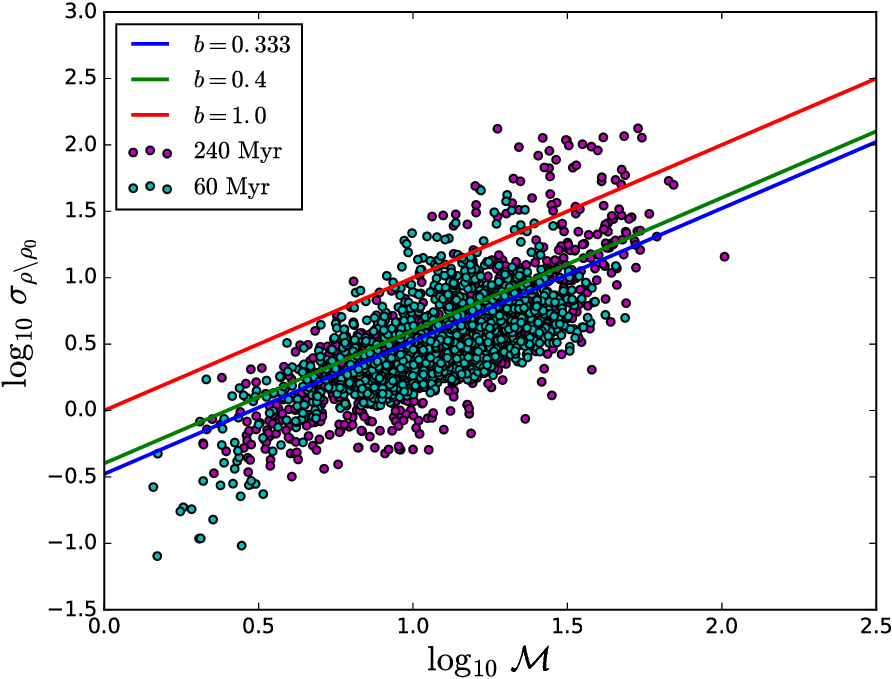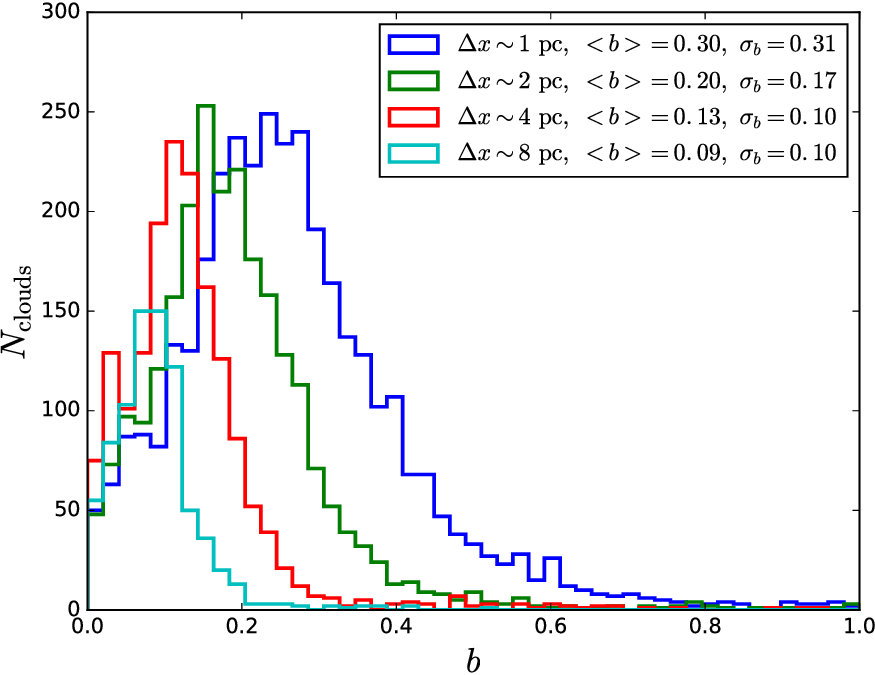
Contact Info
Australian National University
christoph.federrath@anu.edu.au
+61 (0)2 6125 0217
0000-0002-0706-2306
GitHub Bitbucket
We determine the physical properties and turbulence driving mode of molecular clouds formed in numerical simulations of a Milky Way-type disc galaxy with parsec-scale resolution. The clouds form through gravitational fragmentation of the gas, leading to average values for mass, radii and velocity dispersion in good agreement with observations of Milky Way clouds. The driving parameter (b) for the turbulence within each cloud is characterised by the ratio of the density contrast (sigma_rho) to the average Mach number (Mach) within the cloud, b = sigma_rho/Mach. As shown in previous works, b ~ 1/3 indicates solenoidal (divergence-free) driving and b ~ 1 indicates compressive (curl-free) driving. We find that the average b value of all the clouds formed in the simulations has a lower limit of b > 0.2. Importantly, we find that b has a broad distribution, covering values from purely solenoidal to purely compressive driving. Tracking the evolution of individual clouds reveals that the b value for each cloud does not vary significantly over their lifetime. Finally, we perform a resolution study with minimum cell sizes of 8, 4, 2 and 1 pc and find that the average b value increases with increasing resolution. Therefore, we conclude that our measured b values are strictly lower limits and that a resolution better than 1 pc is required for convergence. However, regardless of the resolution, we find that b varies by factors of a few in all cases, which means that the effective driving mode alters significantly from cloud to cloud.
The following shows a movie of the column density of our galaxy simulation, zoomed-in on a high-resolution region in the galactic disc (the x and y axes are in relative coordinates from the centre of the image frames in kilo parsec).
[ turb_driv_gal.mp4, 7.3MB high-res mp4 ]

The Figure shows the standard deviation of turbulent density fluctuations as a function of sonic Mach number in the galaxy simulation. The distribution of clouds (individual data points in the plot) shows that the driving of turbulence in the molecular clouds formed in these simulations ranges from purely solenoidal (b ~ 0.3) to purely compressive driving (b ~ 1). These results show that turbulence driving by galaxy dynamics and cloud-cloud collisions can take on all possible mixtures between solenoidal and compressive, depending on the individual cloud and time considered.

The distribution of turbulence driving parameters (b) for different numerical resolutions in the simulations. The present global galaxy simulations are not converged and the turbulence driving parameters (b) still keep increasing with increasing resolution. Numerical convergence is expected to require resolutions better than ~ 0.1 pc.
We thank the anonymous referee for their detailed comments, which helped to improve this work. Numerical computations were carried out on Cray XC30 at the Center for Computational Astrophysics (CfCA) of the National Astronomical Observatory of Japan. The authors would like to thank the YT development team for many helpful analysis support (Turk et al. 2011). C.F. acknowledges funding provided by the Australian Research Council's Discovery Projects (grants DP150104329 and DP17010603). C.F. further thanks the Leibniz Rechenzentrum and the Gauss Centre for Supercomputing (grants pr32lo, pr48pi and GCS Large-scale project 10391), the Partnership for Advanced Computing in Europe (PRACE grant pr89mu), and the Australian National Computational Infrastructure (grant ek9), as well as the Pawsey Supercomputing Centre with funding from the Australian Government and the Government of Western Australia. E.J.T. was partially funded by the MEXT grant for the Tenure Track System. D.M.S. gratefully acknowledges funding from the Australian Government's New Colombo Plan. This work is partly supported by JSPS Grant-in-Aid for Scientific Research Number 15K0514.